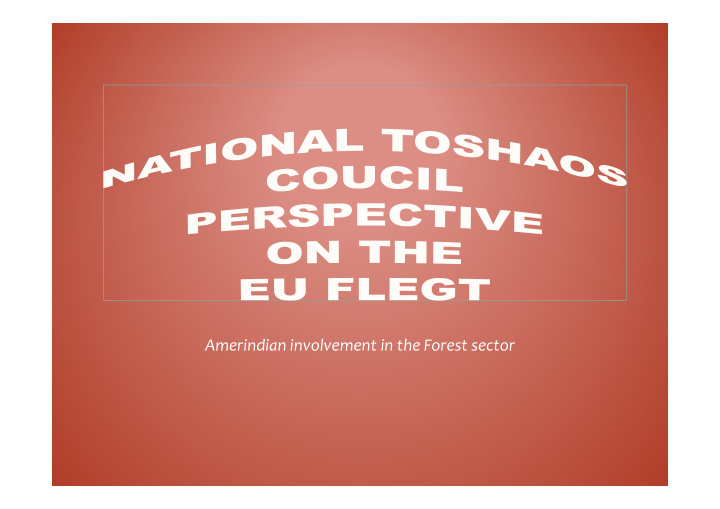



Amerindian involvement in the Forest sector
COMPOSITION AND ESTABLISHMENT OF THE NATIONAL TOSHAOS COUNCIL • All elected village and community leaders. • Twenty executive members from all ten administrative regions. • Established according to the Amerindian act 2006.
ROLE OF THE NATOINAL TOSHAOS COUNCIL • To promote good governance in indigenous village. • To investigate issues affecting indigenous people. • To prepare strategies and plans as it relates to reducing poverty and improve access to health and education. • To prepare strategies and plans for the protection conservation and sustainable management of village managements of village lands and natural resources found therein. • To represent and make recommendation to Government and agencies nationally and internationally on behalf of indigenous people.
INDIGENOUS OWNERSHIP TO LAND Indigenous people own approximately 14% of Guyana land MASS. • • Titled village have legal titles to land • To date over 100 villages have received titles to their land and 35 communities are in the process. • All forest resources found on titled lands are manage by the villages. • Village council develop their own rules and regulations to manage their forest resources. • Any timber sustainable harvest within Amerindian lands by a resident logger is deem legal.
CHALLENGES FACED BY AMERINDIAN VILLAGES • Minimum skilled person in village. • Absence community of forest rangers. • Lack of I.T devices. • Lack of financial resources to conduct awareness sessions in each Amerindian village. • High transportation cost to access Amerindian villages. • Limited communication among village due to geographical location.
PROPOSE BENEFITS OF EU FLEGT • Availability of more markets for timber an timber products. • Improve forest monitoring. • Capacity building for village councils and loggers . • More support to enforce sustainable harvesting of forest produce. • Opportunity to partner with other stakeholders to promote better forest governance.
INDIGENOUS INVOLVEMENT IN THE FLEGT VPA PROCESS • In March 2010 the NTC was invited to the stakeholders preliminary discussion on the FLEGT VPA • In September 2010 the NTC was involved in the exploratory workshop with various stakeholders on the EU FLEGT. • NTC is a member of the national technical working group that oversee the FLEGT VPA process in Guyana. • The NTC was part of the two negotiation sessions between Guyana and the EU held so far.
• In March 2013 workshop was held on the VPA focusing on the legality definition, TOR’s for communication strategy and impact study with 28 Amerindian communities • Amerindian NGO’s are also part of the stakeholders constituency groupings • In August 2013 the NTC did outreach awareness sessions on the FLEGT VPA with Amerindian communities in Region 1. • In October 2013 Presentation on the FLEGT VPA was done at the National Toshaos Conference to over 198 Amerindian leaders. • Several outreach and consultation on FLEGT process among these indigenous communities. • An indigenous NGO is presently conducting workshop on the VPA indigenous communities.
INDIGENOUS PARTICIPATION IN ONE OF THE STAKEHOLDERS MEETING ON THE VPA
RECOMMENDATIONS • All Amerindian village lands should be clearly demarcated and titles be given. • Proposed extension areas should not be given as concessions to miners or foresters. • Some forest regulations need to be reviewed as it relate indigenous communities. • Better road links need to be develop to reduce transportation cost. • Processing facilities need to be establish in village to add value to forest produces. • More funding need to be made available to the NTC so that more awareness outreach can be done. • More
THANK YOU
Recommend
More recommend